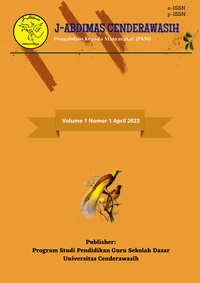Pelatihan Pembuatan Buku Ajar Berbasis Canva Pada Guru MGMP IPA Kabupaten Keerom, Papua.
DOI:
https://doi.org/10.31957/jabdimascenderawasih.v2i1.4028Abstract
The development of digital technology has brought significant changes to the world of education, especially in the delivery of teaching materials. Canva provides an easy-to-use platform for creating interesting and interactive teaching materials. In this context, Canva-based textbook creation training is important for teachers, especially those who are members of the Keerom Regency Science MGMP, to improve their skills and educational effectiveness. The training took place over several sessions, including an introduction to Canva, textbook prototyping, interactive content preparation, and design review. The training participants were 30 science teachers who were members of the Keerom Regency Science MGMP from various schools. Data was collected through pre- and post-test questionnaires to measure participants' advanced knowledge and skills when using Canva. The teachers' knowledge of the Canva application before the training was only 6 teachers who were at a good and very good level, and after completing the training, all 30 teachers were at a good and very good level, knowing about the Canva application in the form of graphic design applications, especially for making textbooks..
Downloads
References
Alghamdi, A. (2021). The Impact of Using Canva to Improve the Quality of Digital Learning Resources. Journal of Educational Technology Development and Exchange, 14(2), 87-98. doi:10.18785/jetde.1402.06
Dennis, A. L., & Heeks, R. (2021). The impact of e-textbooks on learning and satisfaction: A longitudinal study. Education and Information Technologies, 26(1), 185-204. doi:10.1007/s10639-020-10259-5
Duarte, N. (2020). Visual Literacy in Teaching and Learning: Using Canva for Better Presentations. Educational Media International, 57(2), 123-135. doi:10.1080/09523987.2020.1786771
Hameed, A., & Shaikh, S. (2020). Impact of structured textbooks on students' academic performance. Journal of Education and Educational Development, 7(1), 15-25. doi:10.22555/joeed.v7i1.3087
Karaduman, A. (2020). The Use of Canva as a Tool for Design in Education. Journal of Education and Training Studies, 8(3), 1-11. doi:10.11114/jets.v8i3.4728
Kim, D., & Ng, H. (2019). Enhancing Learning Experience through Online Graphic Design Tools: A Case Study of Canva. Journal of Education and Learning, 8(6), 90-100. doi:10.5539/jel.v8n6p90
Rockinson-Szapkiw, A. J., Courduff, J., Carter, K., & Bennett, D. (2013). Electronic versus traditional print textbooks: A comparison study on the influence of university students' learning. Computers & Education, 63, 259-266. doi:10.1016/j.compedu.2012.11.022
Ross, S. A., & Ba, N. D. (2020). The effects of e-textbooks on student achievement in a community college. Journal of Educational Technology Systems, 48(4), 569-586. doi:10.1177/0047239520912395.
Shroff, R. H., & Vogel, D. R. (2009). Assessing the effectiveness of self-directed learning in a context-specific environment. Educational Technology Research and Development, 57(6), 719-735. doi:10.1007/s11423-009-9128-3
Woody, W. D., Daniel, D. B., & Baker, C. A. (2010). E-books or textbooks: Students prefer textbooks. Computers & Education, 55(3), 945-948. doi:10.1016/j.compedu.2010.04.005








